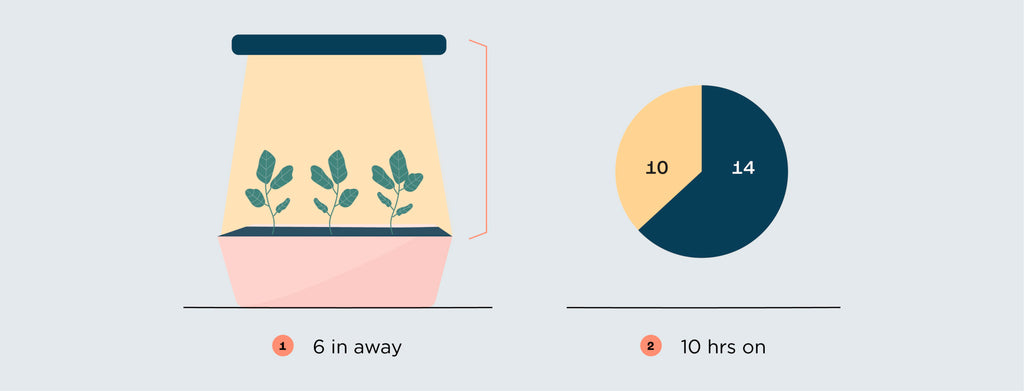When first introduced, pineapples were a sign of wealth and status – costing $8000 per fruit (in today’s dollars). The fruit evoked such jealousy, that a rental market emerged where you could pay to have a pineapple for the night.

Timing
Harvest from Year 2+ on.

Part sun
Equivalent of 5+ hours of direct sun [DLI of 15+ mol/m²/day].

Care
Intermediate. You’ll transplant, prune, and harvest.
Can you Grow Pineapple Indoors?
To answer your question if you can grow pineapple indoors, yes, pineapples can be grown indoors too. Here are some of the varieties that we recommend:
Queen Victoria
It’s a smaller variety that produces fruit in the 2 to 3-pound range. This fruit stores well after being harvested.
John Vena ProduceSugarloaf
It is a unique pineapple variety with an exceptionally sweet flavor. Its overall nutritional content provides digestive and immune support, as well as anti-inflammatory benefits.
AmazonBest Setup for Pineapple Plants
You’ll need:
Planter:
A pot that is at least 10″ / 3 gal, though there is some flexibility. The plant will grow in proportion to its planter – so size is based on how tall you want your plant to grow.
Soil:
Free-Draining Mix
Plant Food:
Balanced Blend. This should be equal parts nitrogen, phosphorus, and potassium (with NPK numbers like 10-10-10).
Grow Light:
A strong grow light that can give the equivalent of 5+ hours of direct sun [DLI of 15+ mol/m²/day].
Jump to: Our product recommendations
Growing Pineapple Indoors: Seed vs Propagate
Growing pineapple indoors for eating is always started with a live plant or cutting. This is because plants grown from seeds will grow as “wild types” – meaning they won’t produce the same fruit they came from (think of crab apples!).
Why you shouldn’t start Pineapple from seed
If you grow a Pineapple from seed, it won’t grow “true to type” meaning the fruit you get will be a weird cross between the many different varieties – and chances are it won’t taste very good.
How to Transplant Pineapple

Live starter plants give you a big jump start on your first harvest. When you’re in a garden center, pick the bushiest plant available (tall and lanky ones will be weak growers) and give it a good inspection for pests. Leaves should be dark green without holes, spots, or curled edges. Quarantine your plant for about a week after bringing it home to ensure it’s free and clear of pests.
Ensuring it’s pest and disease-free it’s time to transplant your seedling into its final home.
- Remove some soil from its final planter – leaving enough space for the bottom of the seedling to be just higher than the soil surface.
- Hold on to the base of the stem with one hand, and turn the pot over while gently pulling the seedling. Giving the pot a few squeezes can help dislodge it.
- Place in its final container and fill around it with soil so that it’s tight but not compacted.
Where to Grow Your Pineapple Plants: Inside or Outside Your Home?
Pineapple plants need lots of light to grow and develop good flavor. Sunlight is excellent for plant growth (and free!) and you might be lucky enough to have a spot that gets the 5+ hours of direct sun they need. When growing pineapple indoors, even with a bright window, it’s unlikely that you’ll have enough natural light in the winter, so we recommend a grow light for anyone who wants a constant supply of flavorful produce.
For an introduction to grow lights, head over to our post on grow lights for indoor gardeners. We’ve also got a buying guide for screw in types, but to keep things simple in this guide, we’ll just provide directions for the 24W Screw in Bulb by Sansi, which we think is a good middle-of-the-road option.

How Bright Should Your Grow Light Be?
Pineapple plants need the equivalent of 5+ hours of direct sunlight (DLI of 15+ mol/m²/day) to grow their best. The 24W Sansi bulb should be placed 6 inches away from the top of the plant. This will give your PPFD (the standard measure of brightness) of 500 μmol/m²/s.
How Many Hours Per Day Do Your Pineapple Plants Need Under a Grow Light?
Pineapple plants are known as “short-day,” meaning they’ll develop faster if they sense over 12 hours of darkness. We recommend setting up a timer to leave the grow light on for only 10 hours per day.
Pineapple Plants Grow Faster in Warmer Temps
Pineapple plants are native to tropical regions and like lots of heat, classifying them as “warm weather crops.” Sunnier and south-facing windows help keep things warmer – ideally 80°F but anything between 60 and 90°F is fine.
Year 2+: Don’t Pollinate Your Pineapple Flowers
Pineapple plants will flower about 2 years after they’ve been planted. They don’t need to be pollinated to form fruit (and if they are pollinated they get seeds and are less nice to eat). After the flowers form, it generally takes 6 months for pineapples to reach their full, ripe size.
Year 3+: How to Harvest Pineapples
Pineapples are ready to pick when the entire outer skin turns yellow and the fruit has a strong pineapple smell. Pineapples won’t ripen after they are harvested, so you’ll want to wait until they’re perfectly ripe on the plant.
Year 3: End of Life
Pineapple plants can produce 2 or 3 pineapples in their lifetime (the first will be the biggest), but will also produce side shoots that you can use to grow new pineapple plants.
Shop This Blog
The right supplies can take the guesswork out of caring for your plants – and turn care from a daily to weekly routine. Through our grow tests, we’ve found these products to produce the best indoor Pineapple (and also have simple maintenance). Plants are adaptable and can grow in many different conditions, so they are by no means necessary if you already have other supplies.
Best Containers for Pineapple: Ceramic Self Watering Planters
Plants thrive on consistent moisture but can suffer if they’re waterlogged. A semi-porous ceramic self-regulates ideal conditions. Our favorite is the COSWIP planter. Runner up is the XS Self Watering Planter by Wet Pot.
Best Soil for Pineapple: Free Draining Mix
Pineapple needs a drier environment – so you are better off using a free-draining cactus potting mix – we like this Organic Mix by Espoma.
Best Nutrients for Pineapple: Balanced Blend
Pineapple likes nutrients that are equal parts nitrogen, phosphorus, and potassium (with NPK numbers like 10-10-10). For a Balanced Blend we recommend: Dr Earth All Purpose
Best Light for Pineapple: DIY or Soltech
There is a very small chance that you have the bright windows needed to grow these without a grow light. If you are looking for a higher-end option – we love the Aspect Light by Soltech. For a more affordable option, a DIY setup using a 24W Screw-in Bulb by Sansi with a Clamp Light and Mechanical Timer works well too. Check out our complete guide on a DIY setup for less than $40 or our buying guide for screw in bulbs.








I rooted a pineapple top several years ago. It gave me one small pineapple and the stem started drooping before ripened. I planted that pineapple and it seems to be growing.
My question: the original plant has a side shoot but its position makes me think I need to put it in soil. What should I do? The parent plant isn’t looking so great!